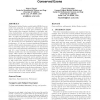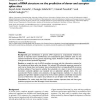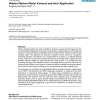10 search results - page 2 / 2 » Identification of clustered microRNAs using an ab initio pre... |
RECOMB
2004
Springer
14 years 5 months ago
2004
Springer
Phylogenetic hidden Markov models (phylo-HMMs) have recently been proposed as a means for addressing a multispecies version of the ab initio gene prediction problem. These models ...
BMCBI
2006
13 years 5 months ago
2006
Background: gene identification in genomic DNA sequences by computational methods has become an important task in bioinformatics and computational gene prediction tools are now es...
BMCBI
2006
13 years 5 months ago
2006
Background: High density oligonucleotide tiling arrays are an effective and powerful platform for conducting unbiased genome-wide studies. The ab initio probe selection method emp...
BMCBI
2005
13 years 5 months ago
2005
Background: Secondary structure is used in hierarchical classification of protein structures, identification of protein features, such as helix caps and loops, for fold recognitio...
BMCBI
2006
13 years 5 months ago
2006
Markov statistical methods may make it possible to develop an unsupervised learning process that can automatically identify genomic structure in prokaryotes in a comprehensive way...




